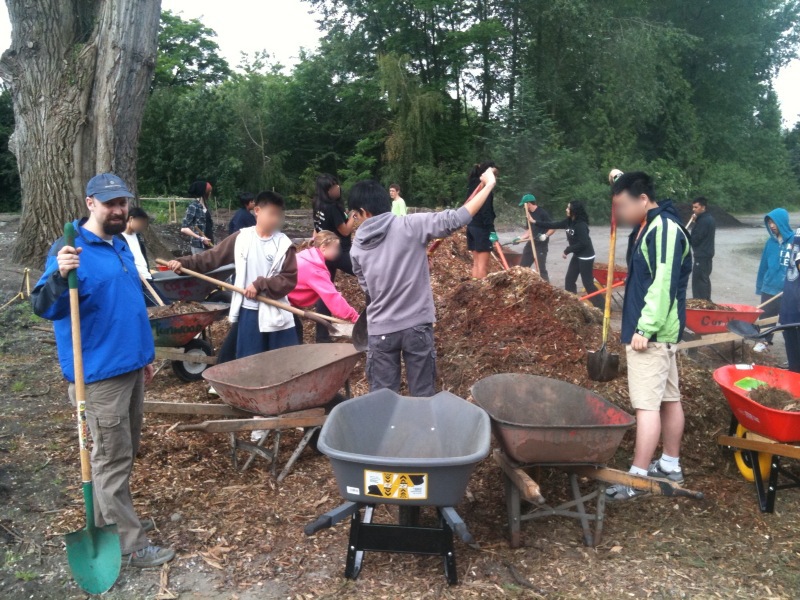Sitting in an Open Source lab with a bunch of computers set up as thin clients from a central server. Has the advantage of easy updates to software since it is all done on a single computer but the particular set-up in the Open Source lab room was apparently having issues all day and crashing fairly easily. My own client choked half-way through the tutorial on Blender, so I had to switch to my laptop, but I was really glad I brought my laptop.
First we watched a movie created using Blender called "The Lighthouse". Pretty cool film, the animation looks spectacular with a lots of special effects, and a good simple storyline. You can watch it online below.
This could be a good way to introduce your students to Blender and hook their attention, if they realize that they are learning the software tool which was used to create this movie. Blender allows users to create incredibly detailed 3 dimension models, optionally animate those models, and then render these animated (or static) models into a video. It’s really an amazing platform for student creativity.
I have to admit, I had attempted to use Blender on my own first, and found it quite intimidating, so I went and found an online Wikibook manual, which I reviewed for about 30 minutes, and I found it helped me get over a bit of that early and steep learning curve with Blender. You can access this tutorial yourself here: http://en.wikibooks.org/wiki/Blender_3D:_Noob_to_Prp
According to our instructor, there are a lot of Blender tutorials available on Youtube, which can be handy as you can actually see the buttons being clicked, etc…
The most important point to know about Blender is that it is a program which uses a 3 button mouse (although there are some work-arounds for people not using such a mouse) and many, many keyboard shortcuts. You need to learn both how the mouse is intended to work and what the keyboard shortcuts are. A cheatsheet would be useful here, I recommend printing one out and having it sit beside you as you are learning how to use Blender. The other important point that our instructor pointed out is that the keyboard shortcuts are tied to where the mouse is on the screen.
Another observation he had was that the program itself may not be suitable for general use. It would be better to use this program with students who are really motivated, or expect to spend more effort teaching how to use the program. Blender takes a huge amount of focus and effort to learn, but once students have some of the keyboard commands memorized, then what they can do with the program is amazing.
In order to really learn how to use the program, I strongly recommend either reading the tutorial linked above, watching examples on Youtube, or looking at one of the many resources available here: http://www.blender.org/education-help/












 In the 9th grade, our guiding question is, "How as Imperialism affected our society?" and we are looking a specific focus of Central and South America and the colonization of those parts of the world. In Mathematics, my task was, "Determine how much sugar could a galleon carry?" which was relevant because sugar is an example of a trade resource upon which the colonies depended. Here is the task sheet I
In the 9th grade, our guiding question is, "How as Imperialism affected our society?" and we are looking a specific focus of Central and South America and the colonization of those parts of the world. In Mathematics, my task was, "Determine how much sugar could a galleon carry?" which was relevant because sugar is an example of a trade resource upon which the colonies depended. Here is the task sheet I  In the 10th grade, our guiding question is, "How do we best get our voice heard? Is it through Science, Math, or Language?" We start by gathering evidence in all three subjects, specifically on the environmental effect of large multinational organization policies can have on small impoverished countries. We complete our week with a trial, in which students will present their scientific or mathematical evidence to their teachers. They will also role-play either French speaking or Spanish speaking people’s of said countries (we originally said that this case was a comparison of the Dominican Republic and Haiti) who have been affected by the multinational organization.
In the 10th grade, our guiding question is, "How do we best get our voice heard? Is it through Science, Math, or Language?" We start by gathering evidence in all three subjects, specifically on the environmental effect of large multinational organization policies can have on small impoverished countries. We complete our week with a trial, in which students will present their scientific or mathematical evidence to their teachers. They will also role-play either French speaking or Spanish speaking people’s of said countries (we originally said that this case was a comparison of the Dominican Republic and Haiti) who have been affected by the multinational organization.

